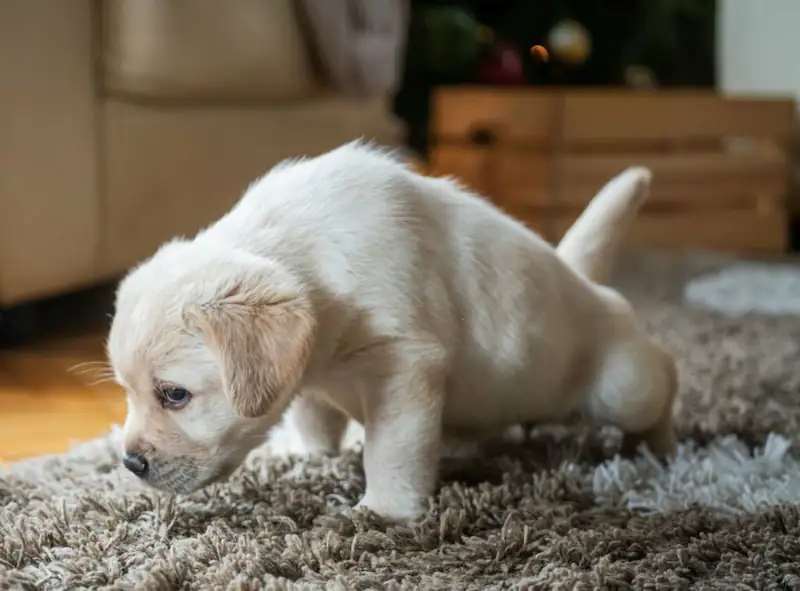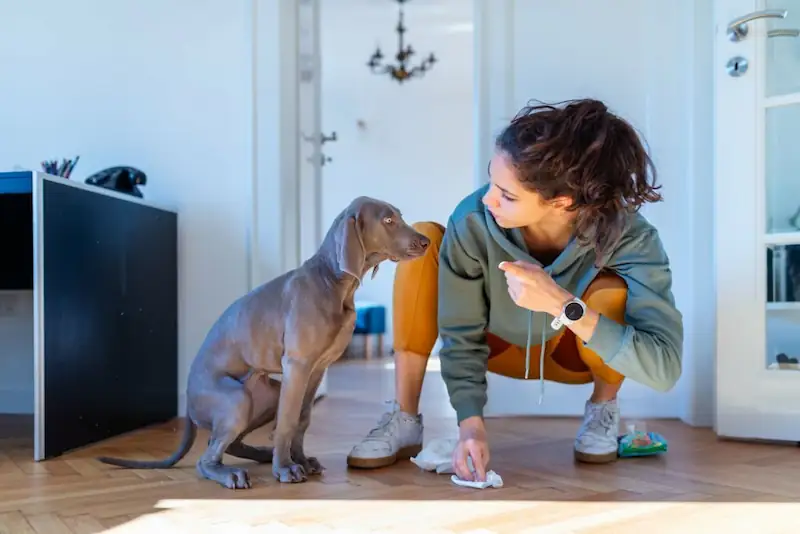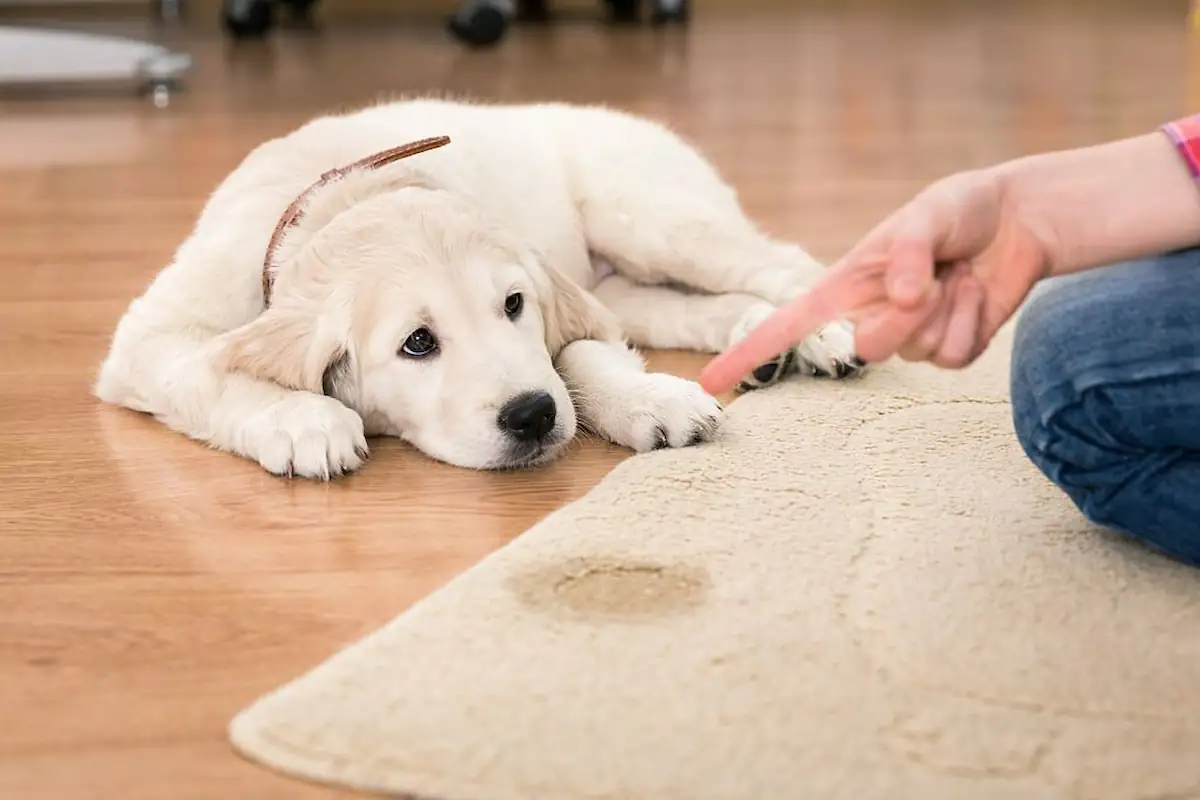Dealing with a dog that won’t stop peeing in the house can be a frustrating situation. Fortunately, it is one that is relatively easy to fix – if you know how to do it correctly, that is. Inappropriate urination is a more common problem than you might think, it can affect any household. And, there are many things that could be causing the behavior.
The trick is to find out the root cause of the problem and then address it (or them) accordingly. The following guide not only breaks down the most common causes of dogs peeing in the house but will also explain how to handle the problem at hand… err paw.
Why Do Dogs Pee In The House?

07. Behavioral Issues
Behavioral issues can play a rather large role in your dog urinating in the house and are, more often than not, the reason for the inappropriate urination. There are many variables regarding the development of behavioral issues and they can be triggered for a variety of different reasons. Changes in the dog’s environment, a shift in their owners’ schedule, or even newly acquired, yet unknown, health problems can bring about conduct disorders.
Separation anxiety is an extremely common one and one that can develop at any time. This particular issue is usually characterized by improper and incessant noise (barking, howling, whimpering), extreme anxiety, and a whole host of destructive behaviors which typically include urinating and/or defecating in the house. For more information about separation anxiety in dogs, please check out this article.
06. Age
As your furry friend starts to get older, it can become more and more difficult for him to ‘hold it’. This can be due to prostate issues (in males), progressively worsening health, or simply from aging which can come with weakened bladder control. The first step is to, of course, plan a visit to the veterinarian so that you can eliminate any possible medical reasons for the incontinence issue. From there, a medical plan for treatment should be put in place based on your dog’s unique situation.
05. Medical Problems
One of the very first things that likely needs to be ruled out is the possibility of any kind of underlying medical condition. Quite a few different illnesses or ailments can cause sudden incontinence, such as diabetes and urinary problems like bladder stones and/or urinary tract infections. Most of which can be easily treated and should stop the inappropriate urinating.
04. Insufficient Training
A dog that is not completely or correctly housebroken is likely to have accidents in the house. This is especially true for pets that have been in and out of multiple households. With each home, comes a new set of rules and ways of following them. While a previous owner may have been happy with the dog using puppy pads, another could have been pushing for traditional potty training. Many times you will have to start the training process from scratch and train Fido the way that you want him to be trained.
03. Territorial Marking

Another super frequent cause of inappropriate urination is territorial marking. When a dog (or cat for that matter) is not sterilized, they will start ‘spraying’, or marking their territory once they reach maturity. The tell-tale signs of this are exhibited by urinating on upright surfaces like the legs of tables. This happens for a number of other reasons but is most often due to the pet not being fixed and being allowed to go into a heat cycle – so remember to spay/neuter your furry friends’ folks!
02. Submissive And Excitement Urination
Does your dog tinkle whenever someone new visits your home or when he gets nervous? This is called submissive or excitement urination and it is not exactly unusual – especially with certain breeds like King Charles Spaniel. However, other things can trigger the behavior such as background and environmental factors. Depending on the reasons behind it, it should be fairly simple to correct the behavior.
01. Excessive Thirst
This might seem obvious but if your pooch is drinking too much water, it can cause him to urinate more frequently and sometimes in undesirable locations. The source of the excessive thirst could be due to anything from too much exercise to an unknown health condition, for example, diabetes can cause extreme thirstiness.
Having your veterinarian rule a medical cause out should be the first thing on the to-do list, barring that, be sure that your dog is not overdrinking. A dog only needs about ½ to 1 ounce of water for each pound of body weight each day. However, this should be adjusted accordingly (IE: if your dog spends a lot of time outdoors).
how to stop your dog from peeing in the house

Now that the source of the behavior has been pinpointed, a proper solution is going to be needed. And, no, that solution is never going to be giving up your pup – which will only worsen already existing issues and possibly trigger even more to arise. No, the behavior is easy to correct so long as you have the knowledge and the tools. Knowing your dog is the most important one and you’ve already got that covered.
04. Anti-Urination Products
While there are many different anti-accident products on the market, you should be careful of the one that you decide to use. Certain chemicals can cause health complications and it is not uncommon for dogs to have an allergy to certain ingredients.
03. Get Fido On A Schedule
Quite possibly one of the most important factors when it comes to breaking an indoor peeing habit – it would be getting the dog on a set schedule and ensuring that you (and he) stick to it. Having a routine and order makes it much easier for your dog to catch onto what he is supposed to be doing. Knowing that he is to do his business at a specific time will also encourage him to do so.
02. Positive Reinforcement
Most experts agree that positive reinforcement techniques are crucial to any training lessons, and potty training your dog is no exception. Canines tend to be hardwired to seek the approval of their humans and this can be used to your advantage. Be sure to let it be known when he has ‘done his business’ in an appropriate area. Offering a treat or praise (or both!) will reinforce the positive behavior.
01. Calling In The Professionals – Ain’t No Shame In It
Although they are sometimes not given credit for their individuality, canines are, in fact, unique individuals, with their own wants, needs, and personalities. What this means is that what might work for one pup, might not necessarily do any good with your furry friend.
Background, breed, and even genetics can play a significant role in how your particular pooch retains information. Some situations will invariably call for more intervention and expertise than others. There is absolutely no shame in calling a professional to help house-train your dog.
Do’s/Don’ts
- Do be patient. As with anything, relearning bathroom habits is going to take some time and there are likely to be some mistakes along the way.
- Don’t ‘rub his nose in it’. This fairly common disciplinary myth is just that: a myth. Rubbing your dog’s snout in his ‘accident’ will probably have the opposite effect of what was intended. For one thing, he isn’t likely to understand what he is being punished for, especially if he was not caught in the act, secondly, this will more than likely teach him to fear you, essentially impeding any future training attempts.
- Do consult with your veterinarian. Obviously, you know your canine companion best, but his doctor probably knows him pretty well too. Your veterinarian can help formulate a training plan that will work for your specific pooches’ needs, as well as excluding underlying health causes.
- Don’t use physical punishment. As already stated, being physical with your dog will almost certainly teach him to fear you, and that can lead to even more behavioral issues including aggression. When (and only when) you catch Fido actually peeing in the house, make a loud noise, such as clapping your hands and once you have his attention, say ‘no’ or ‘outside’ in a firm, even-toned voice.
- Do acknowledge good behavior. When you come home and there are no accidents in the house, Fido should be praised and/or rewarded. If he urinates outside, again praise or a reward of some sort should be given.
- Don’t give up. It is going to be frustrating and you will probably end up wanting to wash your hands of the entire situation. Don’t. Training must be consistent and when the consistency falters, be assured it will set back your furry friends’ progress.
Helpful Tips
- Designate a potty area. Bringing your pet to the same spot every time will help him associate that particular area with doing his business. The scent left behind will also trigger his need to mark in the same place. Don’t forget his praise when he does go!
- Use special treats. Try to use a different treat for potty training than those used for regular everyday purposes. He will associate his ‘special’ treats specifically with going potty in the correct place.
- Avoid any lifestyle changes. This is not the time to get a new pet, move to a new house, or change his diet or schedule, if at all possible. These stressors will likely make the problem worse.
Potty Training Puppy
Potty training a puppy is an essential step in their upbringing, helping to maintain cleanliness in the home and promote healthy habits. Here are some important steps to successfully potty train a puppy:
1. Choose a Suitable Potty Area
- Designate a consistent spot indoors for the puppy’s potty area, preferably in a quiet and secluded location.
- Ensure the area is protected from drafts and cold, and easily accessible for the puppy.
2. Establish a Schedule
- Set specific time intervals for taking the puppy out to use the potty, such as after meals, naps, and playtime.
- Maintain consistency in the schedule to facilitate the training process.
3. Reward the Puppy
- Use rewards and praise when the puppy urinates or defecates in the appropriate spot.
- Provide rewards immediately after the correct behavior to reinforce positive actions.
4. Encouragement and Supervision
- Maintain continuous supervision of the puppy during training sessions, and keep them close to the designated potty area.
- Respond to signs from the puppy indicating a need to go potty, such as circling or wandering away from usual spots.
5. Handle Accidents Calmly
- If accidents occur indoors, avoid harsh punishment and instead clean up the area thoroughly, avoiding cleaners with strong odors.
- Use pet-specific cleaners to effectively remove odors and stains.
6. Patience and Persistence
- Potty training requires patience and consistency, so don’t lose hope if progress seems slow.
- Remember that puppies need time to learn proper behaviors and may require repeated attempts before fully grasping them.
With patience and proper training, you can teach your puppy how to use the potty successfully and maintain cleanliness in the home effectively.
dog potty training near me
If you’re searching for “dog potty training near me,” you’re likely looking for local resources or services to help with training your dog to use the bathroom appropriately. Here are some steps you can take to find dog potty training options in your area:
1. Online Search
- Start by conducting an online search using search engines like Google or Bing. Use search terms like “dog potty training classes near me” or “dog trainers near me.”
- Browse through the search results to find local dog training facilities or trainers that offer potty training services.
2. Local Pet Stores
- Visit nearby pet stores and inquire about any potty training classes or services they may offer.
- Pet stores often have bulletin boards or flyers advertising dog training classes and services provided by local trainers.
3. Veterinary Clinics
- Contact veterinary clinics in your area and ask if they offer or can recommend dog potty training services.
- Veterinary clinics may have partnerships with local trainers or offer training classes themselves.
4. Dog Training Organizations
- Look for local dog training organizations or clubs in your area. These organizations may offer potty training classes or can recommend reputable trainers.
- Attend dog training events or seminars hosted by these organizations to learn more about available training options.
5. Online Directories
- Use online directories or platforms specializing in connecting pet owners with dog trainers or behaviorists. Examples include websites like Petfinder, Rover, or Thumbtack.
- Filter your search by location to find trainers near you who specialize in potty training.
6. Ask for Recommendations
- Reach out to friends, family, or neighbors who have dogs and ask for recommendations on trainers or classes they’ve used for potty training.
- Personal recommendations can provide valuable insights into the quality and effectiveness of different training options.
By exploring these avenues, you can find local resources or services to help with dog potty training in your area. Remember to research and vet any trainers or facilities before making a decision to ensure they meet your needs and standards.
Final Thoughts
Having and dealing with a dog that has inappropriate urination habits is no doubt stressful but you can take comfort in the fact that many others have been down this path with their favorite furball before and yours will certainly not be the last that has to deal with it. With commitment, consistency, and lots of love, your pooch will be perfectly pee-pee trained in no time at all.

